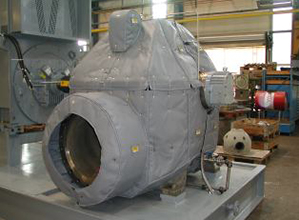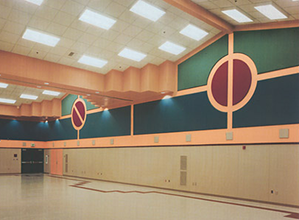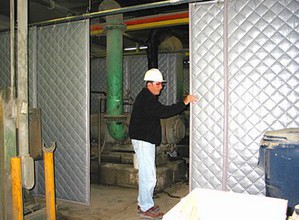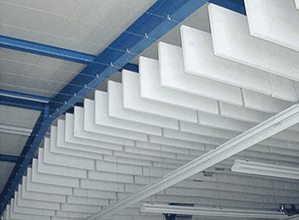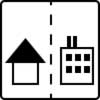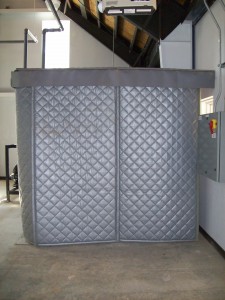Sound Dampening and Noise Containment
Noise is often defined simply as any unwanted sound. Below we will discuss some principles of sound to help you determine the best solution for your noise control application.
What is Noise?
The technical definition of sound is a rapid variation of atmospheric pressure caused by a disturbance of the air. Sound propagates through any elastic medium, such as air, water, wood, or metal, as waves of positive and negative pressure disturbances. Sometimes, these sounds can be intense enough to be a nuisance or cause hearing damage. In these instances, sound control solutions are sought to mitigate the noise problem.
Decibels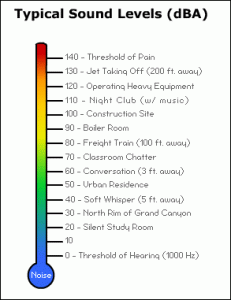
A decibel (dB) is the unit used to measure sound pressure. They are measured on a logarithmic scale, meaning that a small change in the decibel is a much larger change in the amount of actual noise. One of the advantages of the decibel scale is that it provides a reference for sound that is relevant to human hearing. For example 0 dB is the threshold for hearing while the maximum of 140 dB is the threshold of pain. The image to the right shows the decibel scale and the type of noise that is equivalent to each point on the scale. This scale is useful when researching noise mitigation products that advertise a noise reduction in decibels or when reviewing local and municipal noise ordinances.
Why Do I Need Noise Containment?
Workers in industrial and manufacturing environments are often exposed to high levels of sound due to equipment required to operate machinery. Employees in these environments may suffer hearing damage with prolonged exposure to high noise levels. The noise chart above shows that industrial environments can experience noise levels of 90 dBA or more. In the United States, OSHA has set a maximum of 85 dBA time-weighted-average. The table below shows manufacturing industries that often exhibit high noise levels.
| NAICS Title | |||||||
|---|---|---|---|---|---|---|---|
| NAICS Title | Total Records | Median dBA | Number of Measurements in dBA range | ||||
| 90 to 94 dBA | 95 to 100 dBA | 100 to 104 dBA | 105+ dBA | ||||
| Food Manufacturing | 9,070 | 89.51 | 34 | 11 | 2 | 0 | |
| Beverage and Tobacco Product Manufacturing | 40 | 85.64 | 25 | 0 | 0 | 0 | |
| Textile Product Mills | 2,790 | 89.40 | 31 | 11 | 4 | 1 | |
| Apparel Manufacturing | 828 | 81.32 | 9 | 4 | 0 | 0 | |
| Leather and Allied Product Manufacturing | 551 | 89.71 | 35 | 11 | 2 | 0 | |
| Wood Product Manufacturing | 16,330 | 91.72 | 30 | 22 | 7 | 1 | |
| Paper Manufacturing | 4,344 | 87.90 | 28 | 8 | 1 | 0 | |
| Printing and Related Support Activities | 2,620 | 82.22 | 15 | 2 | 0 | 0 | |
| Petroleum and Coal Products Manufacturing | 376 | 86.72 | 22 | 5 | 1 | 0 | |
| Chemical Manufacturing | 2,611 | 85.20 | 18 | 5 | 1 | 0 | |
| Plastics and Rubber Products Manufacturing | 7,627 | 86.07 | 21 | 6 | 2 | 0 | |
| Nonmetallic Mineral Product Manufacturing | 5,772 | 88.39 | 26 | 10 | 4 | 1 | |
| Primary Metal Manufacturing | 13,196 | 91.32 | 34 | 19 | 5 | 1 | |
| Fabricated Metal Product Manufacturing | 20,549 | 88.86 | 27 | 13 | 3 | 1 | |
| Machinery Manufacturing | 10,156 | 86.22 | 21 | 8 | 2 | 0 | |
| Computer and Electronic Product Manufacturing | 360 | 85.28 | 23 | 6 | 1 | 0 | |
| Electrical Equipment, Appliance, and Component Manufacturing | 3,889 | 86.54 | 22 | 8 | 2 | 0 | |
| Transportation Equipment Manufacturing | 7,812 | 88.36 | 24 | 12 | 4 | 1 | |
| Furniture and Related Product Manufacturing | 5,292 | 87.83 | 27 | 9 | 2 | 0 | |
| Miscellaneous Manufacturing | 2,770 | 86.78 | 24 | 8 | 3 | 0 | |
[Source: OSHA Technical Manual]
Occupational Noise Exposure
Noise-related hearing loss is one of the most prevalent occupational health concerns in the United States. Thousands of workers suffer from preventable hearing loss due to high workplace noise levels. High levels of workplace noise can also contribute to other health concerns, such as physical and psychological stress, and can reduce workplace productivity, interfere with communication, and contribute to workplace accidents and injuries.
In the United States, employers in general industry are required by OSHA to have in place a Hearing Conservation Program where workers are exposed to a time-weighted-average noise level of 85 dBA or higher over an 8 hour work shift. For work environments experiencing more occupational noise, there are a variety of ways to reduce the noise hazard for employees.
How Do I Dampen Sound in My Facility?
There are many ways to reduce the level of noise in manufacturing and industrial facilities. Some methods require modifications to the building structure, rearrangement of equipment, or installation of sound reducing or absorbing products. An acoustical consultant can help you determine the noise levels in your facility and provide guidance on methods of reducing the noise. Below we will briefly discuss some strategies you can employ to help reduce the overall level of noise in your facility.
Engineering Controls involve modifying or replacing equipment and making physical changes at the noise source or along the transmission path. Many equipment manufacturers offer low-noise machines or sound packages to help reduce the amount of noise generated. Physical barriers or sound enclosures are also effective ways to manage noise from equipment and machinery.
Administrative Controls are changes to the workplace that reduce or eliminate exposure to noise. Examples of this include operating noise machinery during shifts with fewer people exposed, limiting the amount of time employees spend near a noise source, and restricting worker presence to a suitable distance away from noisy equipment.
Learn more about testing the sound levels in your facility and ways to reduce the sound.
